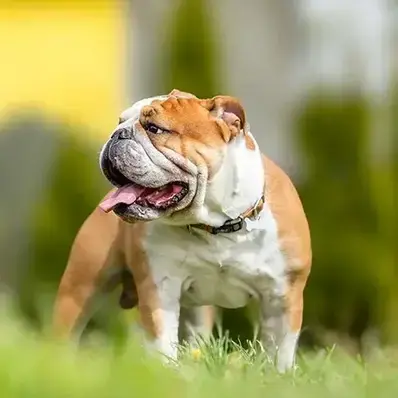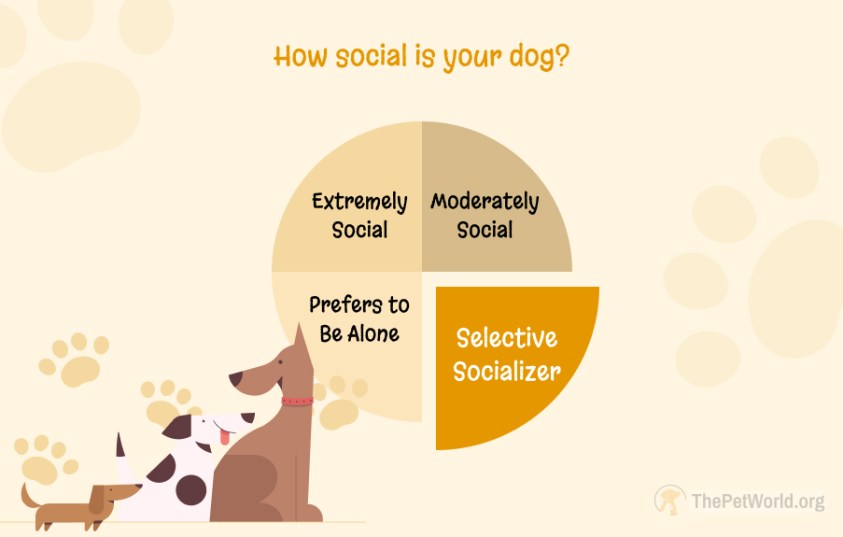Bulldog History/Origin
The modern Bulldog is very different from its ancestors. These purebred dogs descended from ancient mastiff-type breeds and were developed exclusively in England. The first mention of the breed dates back to 1500, describing a man with two “Bolddogges.”
Early Bulldogs were ferocious and involved in the brutal sport of bull-baiting, where they would seize a bull’s nose and shake it vigorously. This practice, although cruel, was believed to tenderize the bull’s meat. It was a popular spectacle before the era of professional sports, television, and movies.
Mastiff Dog – Source: Pixabay
Early Bulldogs were taller and heavier than today’s breed. They were selectively bred to excel at bull-baiting, crawling on their bellies to avoid the bull’s horns and using their powerful jaws to clamp onto the bull’s snout.
Their short, flat noses allowed them to breathe while maintaining their grip, and their pain tolerance was heightened for these battles. The wrinkles on their heads helped redirect blood away from their eyes during the struggle.
The journey to rehabilitate the Bulldog was challenging. 1864 the first Bulldog breed club was formed but disbanded after three years. However, Bulldog enthusiasts persisted, and in 1890, The Bulldog Club of America was founded. They established a new standard for the breed, which was accepted in 1896 and remains in use today.
As Bulldogs were brought to the United States, their popularity grew. They were recognized by the American Kennel Club under Non-Sporting Group in 1890. Throughout the 1940s and 1950s, Bulldogs ranked among the top 10 breeds. Today, they are the 12th most popular breed among the 155 registered by the AKC, showing their status as beloved companions.
The Bulldog’s transformation from a feared creature to a friendly companion is a testament to dedicated breeding practices. This journey reflects the commitment of breeders who exhibited patience, knowledge, and vision, shaping the breed into its best form.
The once-feared Bulldog has become a loving and cherished member of countless families, a triumph of human compassion and dedication.
Bulldog Personality
Bulldogs are one of the dog breeds that exhibit a charismatic character, effortlessly blending sociability with admirable courage, making them natural watchdogs. With a dignified demeanor, they exude sweetness, but don’t be fooled by their laid-back nature; these pups have hearts of gold.
True lovers at heart, their affectionate nature knows no bounds. Once they form a bond with you, it’s unbreakable.
- Temperament
A Bulldog’s temperament is influenced by various factors, including genetics, training, and socialization. When adopting a Bulldog puppy, look for one with a balanced personality—not too timid or too aggressive. Meeting the puppy’s parents and other relatives can provide insight into what to expect as they mature. Early socialization is key to raising well-adjusted Bulldogs. Expose them to a range of experiences, people, and environments during their formative months.
- Potential Challenges
Despite their endearing qualities, Bulldogs can present training challenges. Their stubborn nature requires patience and consistency in training. They may take longer to grasp new commands, and their independent streak means they might not always be eager to follow instructions.
Positive reinforcement and gentle persistence are key to successfully training a Bulldog. Additionally, their laid-back demeanor can sometimes lead to a lack of motivation, so finding ways to keep training sessions engaging and rewarding is essential. Despite these challenges, with the right approach, Bulldogs can become well-behaved and obedient companions.
Bulldog Physical Appearance
The Bulldog, a medium-sized dog, possesses a distinct appearance. It is characterized by a muscular build, prominent wrinkles, and unique facial features. With a compact and sturdy frame, Bulldogs exhibit strength and power, reflecting their historical role as courageous fighters.
A hallmark feature of the Bulldog is its pushed-in nose and flat face, known as a “brachycephalic” trait, which contributes to their endearing and sometimes comical appearance.
- Size
Bulldogs, a medium-sized breed, are known for their sturdy build. Mature males weigh around 50 pounds, females about 40 pounds. Show dogs may be slightly heavier. Bulldogs stand 12 to 15 inches at the shoulder, with low-slung bodies and stocky frames. Despite their short stature, they exude confidence and charm.
- Coat color
The Bulldog’s coat is known for its straight, short, and fine texture, giving it a sleek and shiny look. Bulldogs display a variety of colors, such as red brindle, other brindles, solid white, solid red, fawn, fallow (ranging from pale cream to light fawn, pale yellow, or yellow-red), and piebald (with large patches of two or more colors). Solid black coats are less prevalent and not as favored in this breed.
Bulldog Gender Differences
Male and female bulldogs exhibit distinctions in both size and temperament. There are subtle differences based on individual personality rather than gender. However, these variations are not universal and can vary widely among individual dogs regardless of their gender. Proper training, socialization, and consistent handling are essential for shaping the temperament of Bulldogs of either sex.
Bulldog Feed/Nutrition
Ensuring your Bulldog receives the appropriate amount of high-quality dog food is vital for their overall health and happiness. The recommended daily intake typically ranges from 1/2 to 2 cups, divided into two meals.
However, the exact portion your adult Bulldog requires depends on several factors, such as size, age, metabolism, and activity level. Just like humans, each dog has unique dietary needs that should be considered. You can also offer shrimp as a protein-packed treat, but make sure it’s served in moderation and without any seasoning.
Avoid overfeeding your Bulldog, as excess weight can strain their joints and lead to health complications. It’s advisable to measure their food portions and provide meals twice a day rather than leaving food out continuously.
Bulldog Health
Like all breeds, Bulldogs may be prone to certain diseases and conditions. While not all Bulldogs will experience these health issues, it’s crucial to be aware of them when dealing with breeders and throughout your Bulldog’s life. The following conditions may affect Bulldogs:
- Cherry Eye: Cherry eye is a condition where the gland under the third eyelid protrudes, causing a red, swollen appearance that resembles a cherry. Surgical intervention may be necessary in severe cases. Preventive measures include keeping the eyes clean and seeking prompt veterinary attention for any signs of irritation or swelling.
- Brachycephalic Syndrome: Bulldogs can suffer from obstructed airways due to their short heads and narrowed nostrils, leading to respiratory distress. Treatment options vary. Preventive measures include avoiding strenuous exercise in hot or humid weather and keeping the dog at a healthy weight to reduce airway constriction.
- Demodectic Mange: Caused by mites, this condition can lead to localized or generalized skin problems, especially in dogs with compromised immune systems. Preventive measures include regular grooming to remove dead skin cells and reduce the risk of mite infestations, along with ensuring the dog’s immune system is supported through a balanced diet and appropriate veterinary care.
- Hip Dysplasia: Bulldogs may show signs of hip dysplasia on X-rays due to their shallow hip joints, but proper weight management and exercise can help alleviate symptoms. Preventive measures include providing a diet rich in joint-supporting nutrients, avoiding excessive jumping or high-impact activities, and maintaining a healthy weight to reduce stress on the joints.
- Cancer: Bulldogs, like many other breeds, can be susceptible to various forms of cancer, including mast cell tumors, lymphoma, and bone cancer. Early detection through regular veterinary check-ups and screenings can significantly improve treatment outcomes. Preventive measures include maintaining a healthy lifestyle with regular exercise, a balanced diet, and minimizing exposure to environmental toxins or carcinogens.
- Allergies: Bulldogs may experience allergies to environmental factors like pollen, dust mites, or certain foods. Symptoms may include itching, skin infections, ear infections, or gastrointestinal upset. Preventive measures include identifying and avoiding allergens, maintaining a clean living environment, and providing a well-balanced diet tailored to your dog’s specific dietary needs. Regular grooming and veterinary consultations can help manage allergy symptoms effectively.
Bulldog Care and Grooming
Keeping your Bulldog looking and feeling their best is easy with a regular grooming routine. Brushing their coat weekly with a firm bristle brush removes loose hair and promotes a healthy sheen. Daily facial care is crucial, with gentle cleaning of their wrinkles using baby wipes containing lanolin and aloe vera for extra soothing. Remember to thoroughly dry the wrinkles to prevent irritation, and consult your vet for a special ointment if your Bulldog experiences any redness or itchiness. Regular brushing also helps manage shedding, minimizing unwanted dog hair on your furniture and clothes.
Beyond the fur, grooming includes regular nail trimming (once or twice a month) to start early and get them accustomed to the process. Dental hygiene is equally important, so brushing their teeth two to three times a week prevents tartar buildup.
Bulldogs have a low to moderate energy level, ideal for indoor living. They don’t need much exercise, but daily walks are essential to prevent weight gain. Bulldogs enjoy a relaxed lifestyle, with about 15 minutes of play before needing a nap.
Their adaptable energy suits both apartments and houses with yards. A mile or two walk during cooler times or a short stroll around the block is enough to keep them happy. Leash training your dog is essential to ensure they stay controlled and safe during walks, making outings more enjoyable for both of you.
Bulldog Rescue Groups
Rescue groups dedicated to Bulldogs work tirelessly to provide loving homes for these charming dogs. They focus on rescuing Bulldogs from shelters, abusive situations, or those abandoned by their owners. These organizations ensure that Bulldogs receive necessary medical care, rehabilitation, and proper training. By adopting from a Bulldog rescue, you’re giving a deserving dog a second chance at a happy, healthy life.
Bulldog Price
The price of a Bulldog typically ranges from $1,500 to $2,000, depending on factors such as breeder reputation, pedigree, and location.
When looking to buy a Bulldog, it’s important to seek out reputable breeders who prioritize health and temperament. Ensure the breeder provides health clearances for both puppy and parents to avoid genetic issues.
Interesting Facts
- Bulldogs are well known for their loud snoring, a result of their short snouts and breathing issues. If you’re a light sleeper, a Bulldog might not be the best pet for you.
- Bulldog has appeared in the most famous cartoon show “ Tom and Jerry”.
Tom and Jerry-Source: Wikipedia
- Bulldog has appeared in the TV show “ Family Guy”.
Family Guy-Source: Yarn
Best For
Bulldogs are calm, gentle, and great with children, making them excellent family pets. They require minimal exercise and grooming, suiting less active lifestyles and apartment living. However, potential owners should be prepared for their health issues and snoring. Bulldogs are best for those who can provide proper care and appreciate their unique traits.
Top Names
| Male Bulldogs Names | Female Bulldogs Names |
| Max | Bella |
| Rocky | Daisy |
| Duke | Lola |
| Bruno | Rosie |
| Winston | Molly |









 Mastiff Dog – Source:
Mastiff Dog – Source: 

 Red Bulldog – Source:
Red Bulldog – Source:  White and Brindle Bulldog- Source:
White and Brindle Bulldog- Source:  White Bulldog – Source:
White Bulldog – Source:  Piebald Bulldog- Source:
Piebald Bulldog- Source: 
 Tom and Jerry-Source:
Tom and Jerry-Source:  Family Guy-Source:
Family Guy-Source: 






